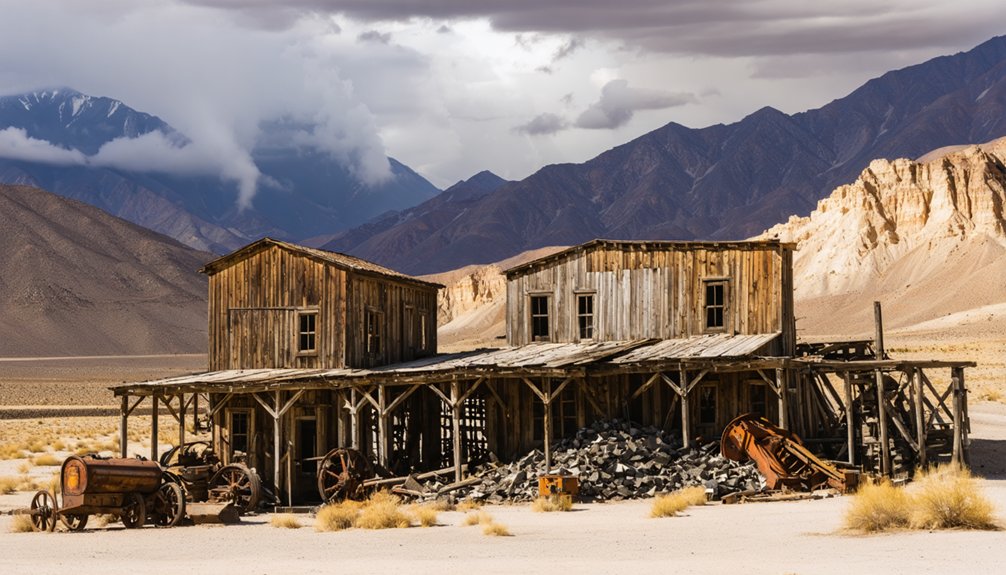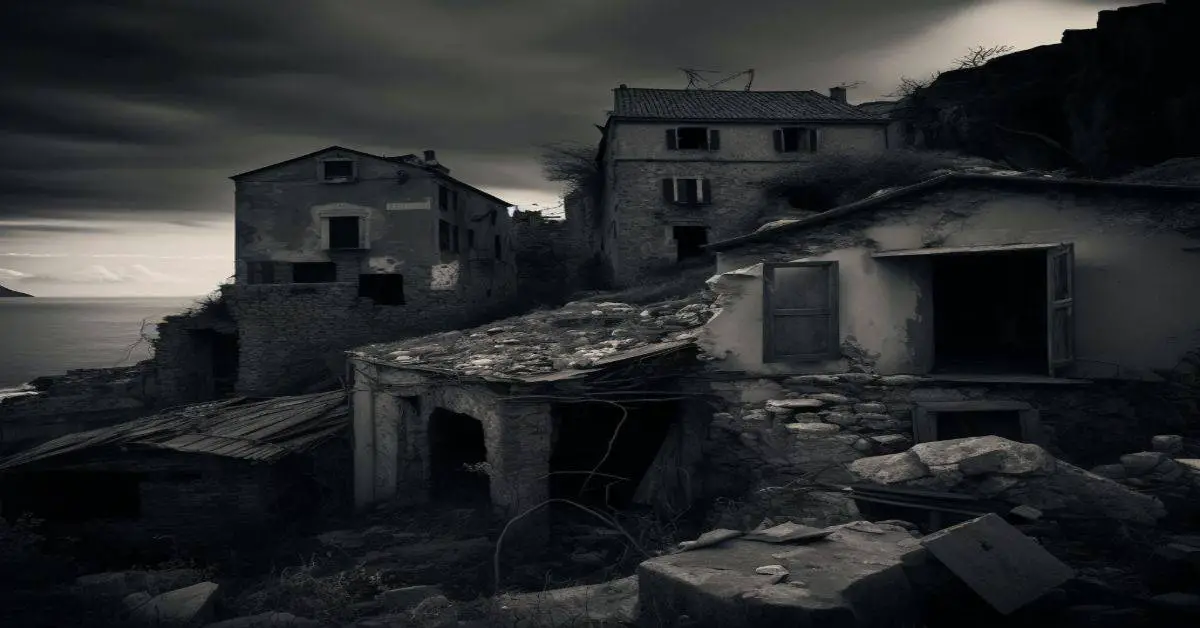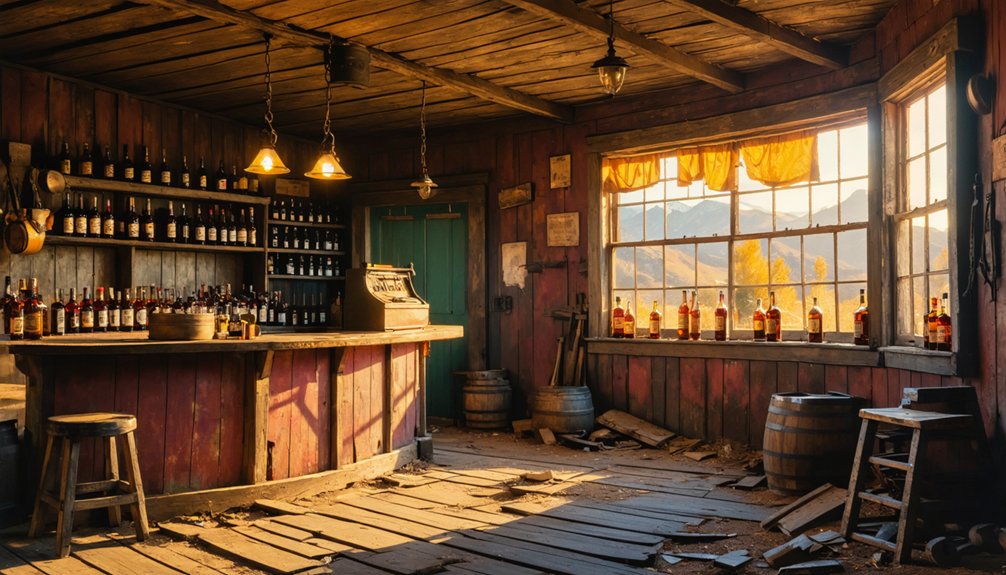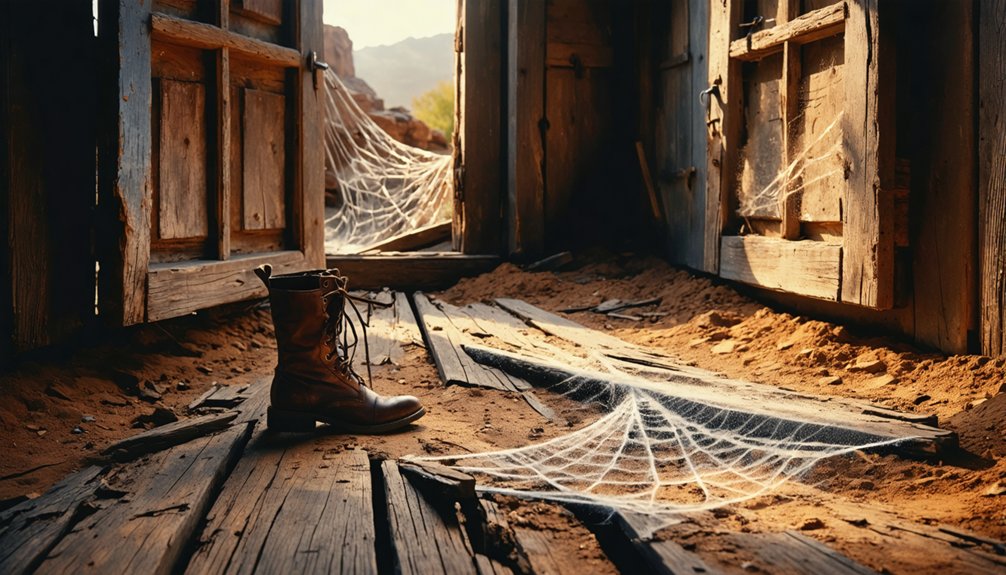Panamint City was a lawless 1870s silver boom town in California’s Surprise Canyon. You’ll find it perched at 6,302 feet where prospectors and outlaws once mingled in this “toughest hellhole” of the West. The town flourished briefly until a devastating 1876 flood wiped out most structures. Today, you can hike the challenging 15-mile trail to explore ruins including the iconic brick smelter chimney and “Panamint Hilton” cabin. The dangerous history awaits your discovery.
Key Takeaways
- Panamint City emerged in 1873 after silver discovery, quickly growing to 2,000 residents by 1874 despite its reputation for violence and lawlessness.
- The ghost town sits at 6,302 feet elevation in Surprise Canyon, with remaining structures including a brick smelter chimney and the “Panamint Hilton” cabin.
- A catastrophic flood in July 1876 destroyed much of the town’s infrastructure, accelerating its decline after earlier economic struggles.
- Visiting requires a challenging 15-mile round-trip hike with 4,360 feet of elevation gain to access approximately 50 historic structures.
- The area holds cultural significance for Timbisha Shoshone people, who inhabited the region long before the brief mining boom.
The Silver Discovery That Sparked a Boom Town
When prospectors William L. Kennedy, Robert Stewart, and Richard C. Jacobs ventured into Surprise Canyon in early 1873, they weren’t expecting to trigger one of California’s most dramatic silver rushes.
Their accidental silver discovery while searching for the Lost Gunsight Mine would transform this remote desert canyon into a thriving boom town almost overnight.
The prospectors’ inability to keep quiet about their find proved consequential. Six stage robbers overheard their plans, tracked them to the site, and forced themselves into partnership.
Despite this rocky start, word spread rapidly, drawing hundreds of fortune-seekers to this rugged terrain by year’s end. The population quickly swelled to approximately 2,000 residents by 1874, creating a bustling mile-long main street filled with businesses. The intervention of Senators John P. Jones and William M. Stewart proved crucial, as they arranged for amnesty for bandits in exchange for valuable silver claims.
Life in “The Toughest Little Hellhole” of the West
In Panamint City, you’d face the constant threat of violence with over fifty shootings recorded during the town’s brief existence.
Your daily routine would include traversing a perilous social landscape where former outlaws mingled with miners along the muddy main street lined with saloons and brothels.
If you managed to survive the human dangers, you’d still contend with the harsh Death Valley environment, remote isolation, and the risk of flash floods that could sweep through the canyon without warning. The town’s extreme elevation of 6,302 feet made weather conditions even more severe and unpredictable.
During winter months, you would experience chilly temperatures that often dropped into the 20s at night, making survival without proper shelter and warm clothing nearly impossible.
Daily Danger Realities
Life in Panamint City earned its notorious reputation as the “toughest, rawest, most hard-boiled little hellhole” of the West through daily realities that threatened survival at every turn.
You’d witness over fifty shootings during the town’s brief existence, traversing rutted, muddy streets lined with hastily constructed huts and tents.
Without Wells Fargo’s security presence, you’d develop community resilience through informal protection networks. Every silver transport risked ambush by outlaws lurking in the canyon.
Your survival strategies would include constant vigilance in a place where violence erupted spontaneously among the dense concentration of saloons and brothels. Founded after a silver strike in 1872, the town quickly attracted those seeking fortune regardless of their character or criminal past.
With no effective law enforcement, you’d face daily unpredictability and threat. The muddy main street, punctuated by rough structures, became a gauntlet where one wrong word could cost your life.
Survival Amid Lawlessness
Surviving in Panamint City demanded more than mere luck—it required deliberate strategies within a lawless vacuum that defined everyday existence.
You’d carry weapons constantly, form community alliances with trusted neighbors, and master the terrain’s escape routes to navigate daily threats.
With Wells Fargo refusing service and over 75 unsolved murders plaguing the region, vigilante justice became your only recourse. The infamous shooting of Nicholas Perasich by B. Ashim in 1875—followed by a corrupted trial—exemplified how wealth and intimidation routinely trumped justice. You’d ship valuable bullion in 400-pound cubes to deter theft while developing emotional resilience against constant danger.
Your resourcefulness strategies extended beyond self-defense to economic adaptation—bartering goods, shifting between mining and odd jobs as circumstances demanded.
The town’s reputation as a silver boomtown drew thousands of desperate fortune-seekers despite the known dangers of the isolated location.
Your reputation determined survival prospects, with outsiders viewed suspiciously. The psychological fortitude required was immense, with residents developing stoicism and fatalism as essential coping mechanisms in this unforgiving hellhole.
Creative Silver Transport: 450-Pound Cannonballs
Faced with persistent bandit threats along the treacherous roads to Los Angeles, Panamint City’s mine owners devised an ingenious anti-theft system unique to their remote silver mining operation.
At the Surprise Valley Mill, they transformed raw silver into massive 450-pound spheres resembling cannonballs.
The cannonball design brilliantly eliminated grip points, making these precious orbs nearly impossible for thieves to handle or conceal. You couldn’t simply grab one and run—their immense weight required multiple men and specialized equipment to move.
This theft prevention strategy eliminated the need for armed escorts through dangerous territory where conventional security measures had repeatedly failed.
When Wells Fargo refused to establish an office in the lawless town, this creative solution became essential for Nevada senators Jones and Stewart to protect their substantial mining investments.
The Notorious Outlaws of Surprise Canyon
The silver cannonballs weren’t the only defense against Panamint City’s criminal element—they were a response to a deeply entrenched outlaw presence that predated the mining operations themselves.
Silver justice forged in fire, a desperate counter to outlaws who claimed the canyons long before miners arrived.
When prospectors discovered silver in 1872, they unknowingly entered a bandit sanctuary where caves and rugged terrain provided perfect hideouts for fugitives.
You’ll find that outlaw collaborations shaped Panamint’s development from its inception, with six stagecoach robbers coercing the original prospectors into partnerships.
These bandit strategies transformed the settlement into a “hard-boiled hellhole” with over fifty shootings during its brief existence.
Most fascinating is how outlaws and mine owners maintained an uneasy alliance. The town earned its reputation as “bad and wicked” due to the constant violence and lawlessness that pervaded daily life.
Senators arranged amnesties for bandits in exchange for repaid funds, effectively legitimizing criminal enterprises while highway robberies and violence continued unabated along the canyon routes.
The harsh, unforgiving landscape of Surprise Canyon provided natural barriers that protected outlaws from law enforcement, making Panamint City an ideal refuge for those fleeing justice.
Natural Disaster and Economic Collapse
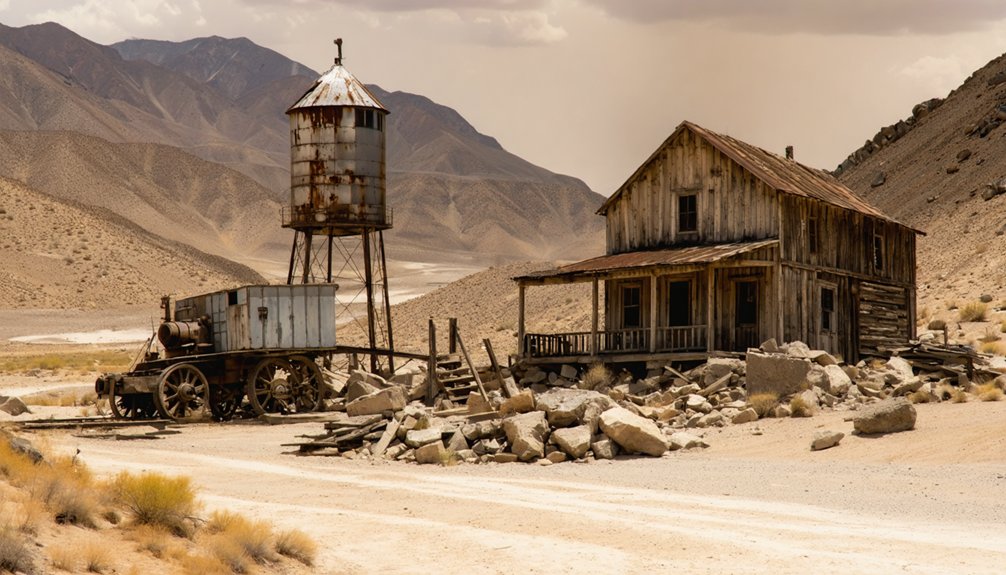
While prospectors battled outlaws and carved a silver empire from Surprise Canyon‘s rocky heart, nature quietly prepared its devastating response.
In late July 1876, atmospheric forces converged over the Panamint Mountains. A monstrous waterspout rose from Owens Lake as moisture-laden clouds dissolved into an Olympic cloudburst. The result: a 5-7 foot wall of water that thundered down Main Street, obliterating Munsinger’s Brewery, Wyoming Restaurant, and countless other establishments.
The flood impact was catastrophic, washing away the town’s critical infrastructure. The deluge destroyed Dave Naegle’s Oriental Saloon along with numerous other buildings that lacked structural integrity.
Yet Panamint City’s economic decline had begun before nature’s assault. Senator Jones and Stewart’s $250,000 claim-buying spree had already concentrated economic control by 1874.
What Remains Today: Exploring the Ruins
Today’s visitors to Panamint City will find a remarkable collection of structural remains scattered throughout the canyon, including stone foundations, the iconic brick smokestack, and several partially intact cabins along what was once Main Street.
You’ll encounter fascinating relics of the mining era, from abandoned ore cars and rail tracks to rusted equipment repurposed as impromptu sculptures by creative hikers.
The “Panamint Hilton” cabin serves as an unexpected oasis amid the ruins, complete with basic furnishings and a functional kitchen for the intrepid explorers who make the challenging journey into this remote ghost town.
Remaining Structures
Scattered across the windswept canyon, Panamint City’s remaining structures tell the poignant story of this once-thriving mining settlement.
Stone foundations outline the ghostly footprint of main street buildings, while parallel walls mark property boundaries along the trail.
The imposing red brick smelter chimney stands as the site’s sentinel, dating from 1875 and surrounded by the crumbling masonry of the Surprise Valley Mill.
Nearby, you’ll find the two-room “Panamint Hilton,” a plywood cabin with intact windows that’s become an unofficial landmark.
Mining infrastructure remains visible throughout the site—collapsed tramway segments, disabled ore cars, and vintage machinery lie scattered among the ruins.
Weather-worn wooden structures and steel-frame buildings compete with nature as the canyon slowly reclaims this monument to freedom and frontier ambition.
Artifacts and Relics
Panamint City’s ruins offer a remarkable treasure trove of artifacts and relics that transport visitors back to its industrial heyday. As you explore, you’ll encounter rusting mining machinery scattered throughout the landscape—rock crushers, collapsed aerial tramways, and the crumbling smokestack from the 1875 Surprise Valley Mill standing as silent sentinels of industrial ambition.
Domestic artifacts tell equally compelling stories. Inside the “Panamint Hilton” cabin, you’ll find surprisingly intact furniture—beds, tables, chairs, and kitchen items abandoned for over a century.
Nearby, colorful mineral specimens of silver-bearing quartz, pyrite, and chalcopyrite reveal what drew prospectors here. Even more ancient treasures await discovery, as Timbisha Shoshone pictographs and petroglyphs in nearby caves demonstrate this area’s rich cultural heritage predating the 1872 silver rush.
Accessing Historic Ruins
While reaching Panamint City’s historic ruins demands considerable effort, the journey rewards adventurous hikers with an unparalleled glimpse into California’s mining past.
The challenging 15-mile out-and-back trek from Chris Wicht’s Camp involves 4,360 feet of elevation gain through Surprise Canyon‘s scenic landscapes of waterfalls and lush vegetation.
What awaits those who conquer these hiking challenges:
- Remnants of approximately 50 historic structures along the original 1.5-mile main street, including foundations of saloons, a bank, and a post office
- Impressive mining infrastructure featuring tunnel chambers, tailings piles, and tramway remains at the Hemlock Mine
- Freedom to explore surrounding areas like Marvel Canyon and Sourdough Canyon, where additional ruins and Native American pictographs await discovery
The Timbisha Shoshone Legacy and Pre-Mining History
Long before prospectors and miners arrived in the Panamint Mountains, the Timbisha Shoshone people established a rich cultural legacy throughout the Death Valley region.
Their Uto-Aztecan ancestors migrated here over a thousand years ago, bringing with them sophisticated survival knowledge that enabled thriving in this harsh landscape.
The Timbisha culture centered around the sacred red-ochre earth they sourced from the Black Hills, using it for both spiritual and medicinal purposes.
Their Indigenous practices included creating multi-purpose baskets, seasonal migration patterns, and agricultural cultivation—growing corn, potatoes, squashes, and melons as documented in 1891.
Frequently Asked Questions
Is Panamint City Accessible by Vehicle Today?
The rugged gateway to the past stands locked. You can’t drive there—road conditions were destroyed by cloudbursts and visitor restrictions permanently closed vehicle access in 2001 after an environmental lawsuit.
Were Any Famous Outlaws Known to Have Hidden in Panamint?
While no confirmed famous outlaws are documented, you’ll find outlaw legends persist about the Tipton gang hiding in Panamint’s rugged canyons, leaving speculation of hidden treasures in this lawless sanctuary.
What Happened to the 450-Pound Silver Cannonballs?
Like Atlantis treasures, the silver cannonballs’ fate remains a cannonball mystery. You’ll find no surviving examples today—they’ve vanished into historical obscurity after silver mining operations ceased in 1877.
Did Any Structures Survive the 1983 Flash Flood?
You’ll find almost no intact structures survived the 1983 flood impact. Only scattered mining equipment remnants and heavily damaged ruins remain, with the canyon scoured down to bedrock by destructive floodwaters.
Are There Any Descendants of Original Panamint Residents Still Living?
Yes, descendants exist through the Timbisha Shoshone Tribe. You’ll find their ancestral connections documented in historical records, tribal enrollments, and descendant stories preserved by families who maintain their Panamint heritage today.
References
- https://www.backpacker.com/trips/trips-by-national-park/death-valley-national-park/hike-ghost-town-panamint-city-death-valley/
- https://www.legendsofamerica.com/ca-panamint/
- https://janmackellcollins.wordpress.com/2024/09/08/remote-hot-and-wicked-panamint-city-california/
- https://westernmininghistory.com/towns/california/panamint-city/
- https://adventuretaco.com/more-than-a-ghost-town-panamint-city-2/
- https://www.nps.gov/deva/learn/historyculture/death-valley-ghost-towns.htm
- http://www.adventureduo.com/2011/04/panamint-city-exploration.html
- https://www.youtube.com/watch?v=VYARDtC5XEM
- https://npshistory.com/publications/deva/hrs/section3a.htm
- https://www.americanheritage.com/panamint-suburb-hell
